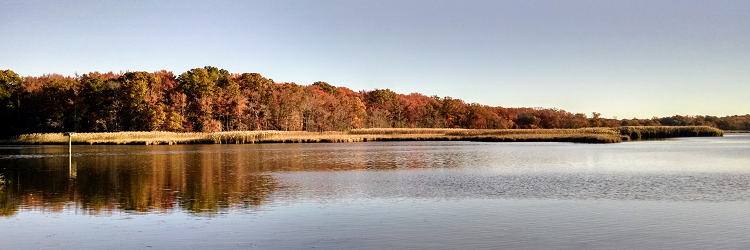 Autumn color creates a striking backdrop along Dundee Creek.
Autumn color creates a striking backdrop along Dundee Creek.
Image courtesy of Michael Miles - MDE.
What is the Chesapeake Bay?
Estuary Basics
The Chesapeake Bay is an estuary (leaving MDE) and is the largest ecosystem of its kind in the United States. Estuaries are partially enclosed coastal bodies of water that occur where freshwater from streams and rivers mixes with saltwater from the ocean. This combination of freshwater and saltwater is called brackish water (leaving MDE) and is responsible for the slightly salty smell of the Bay.
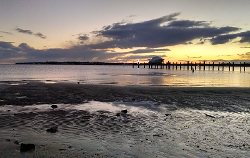 Low tide in the shallows of an estuary creates constantly changing habitats.
Low tide in the shallows of an estuary creates constantly changing habitats.
Image courtesy of Michael Miles - MDE.
A Transition Between the Land and Sea
Estuaries are transitional ecosystems between the land and the sea (leaving MDE). They are composed of wetlands, tidal marshes, mudflats, underwater grass beds, and areas of open water. This varied and dynamic range of habitats provides a home to hundreds of animal and plant species. Additionally, the diverse habitat in the Chesapeake provides vital breeding grounds for many fish and crustacean species; the sheltered tidal marshes provide a safe place for the young to grow while open waters provide swimming and feeding grounds for adults.
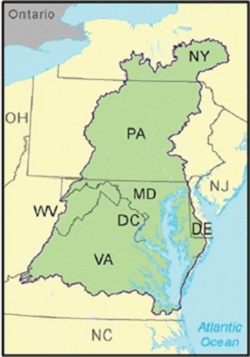 The Chesapeake Bay has a large watershed that spans six states and the District of Columbia.
The Chesapeake Bay has a large watershed that spans six states and the District of Columbia.
Land-Water Interactions
The Source of Freshwater in the Chesapeake
Freshwater flows into the Chesapeake Bay from the surrounding land in a drainage area known as a watershed. Water that falls in the watershed flows into rivers and streams (leaving MDE), or percolates into the groundwater (leaving MDE), where it makes its way into the Chesapeake Bay and ultimately, the Atlantic Ocean.
The Chesapeake Bay has a vast watershed (leaving MDE) that spans 64,000 square miles and encompasses parts of six states; Delaware, Maryland, New York, Pennsylvania, West Virginia, and the entirety of the District of Columbia. Water from these regions flows into the Bay, carrying with it an array of nutrients, sediment, and pollution.
Nutrients Power Productivity
Estuaries are among the most fertile and productive ecosystems in the world. They host a vast amount of biological activity that produces more biomass than similarly sized forest or agricultural land. Nutrient-rich water from the surface drains into the estuary basin and drives biological productivity. Plants and aquatic organisms filter and consume nutrients as they enter the water. This flow of nutrients into the Chesapeake is a delicate balancing act, one that humans have disrupted.
Oxygen in the Water is Essential to Life
Like their air-breathing counterparts, most aquatic life requires oxygen to survive (leaving MDE). Unlike air, water carries relatively little oxygen. To compensate, animals that live and breathe underwater are specially adapted to take as much oxygen as possible from the water. While oxygen levels normally vary in the Bay, human activity has disrupted natural processes that have caused oxygen levels in parts of the Bay to dip dangerously low.
A Home for Plants and Animals
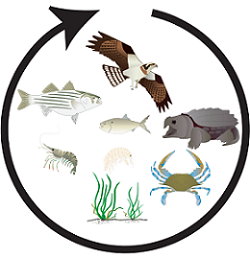 Predators and prey living in the Chesapeake interact in complex food webs.
Predators and prey living in the Chesapeake interact in complex food webs.
Image courtesy of Michael Miles - MDE, Symbols courtesy of the Integration and Application Network, University of Maryland Center for Environmental Science (ian.umces.edu/symbols/).
The Foundations of the Food Chain
Nutrients in the water are essential for life in the Chesapeake. Plants, algae, and plankton feed on nutrients and flourish as a result of the rich waters that flow into the Bay. Organisms that produce their own food using sunlight and nutrient inputs are known as primary producers and form the foundation of the food chain (leaving MDE).
Larger organisms, such as fish, crabs, and mollusks, feed on the primary producers, and in turn, are preyed upon by larger fish, birds, and mammals. Different animals feed on many different organisms in the Chesapeake, forming what is commonly known as a food web. This food web supports a tremendous amount of life in the Bay (leaving MDE) and has benefited humans for thousands of years.
Plants Provide Clean Water and Protection
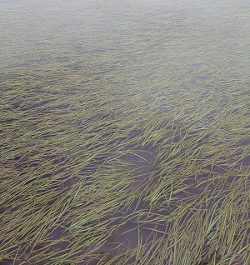 Bay grasses remove nutrients from the water, prevent erosion, and provide habitat to animals.
Bay grasses remove nutrients from the water, prevent erosion, and provide habitat to animals.
Image courtesy of Michael Miles - MDE.
Aquatic plants are of great importance to the Bay (leaving MDE). While few plants can survive the diverse range of habitat found in an estuary (leaving MDE), plants that live in the Bay are specially adapted to survive variable conditions. In particular, Bay plants thrive under variable salt content ranging from the freshwater in the headwaters of the Bay, to the salty waters of the Atlantic Ocean.
Bay plants help filter the water and provide vital breeding grounds and nurseries (leaving MDE) for many species. In addition to forming the foundation of the food web, plants and underwater grasses act as living buffers that shield the Chesapeake’s open waters and shores from storms. This living barrier is a resilient defense against shoreline erosion and helps protect inland ecosystems and valuable shoreline properties from destructive waves.
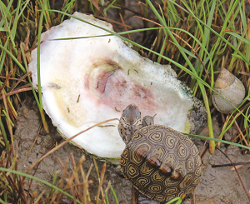 A baby terrapin makes its way to the water.
A baby terrapin makes its way to the water.
Image courtesy of Jane Hawkey - IAN, UMCES.
Wildlife in the Chesapeake
Even in a degraded state, the Chesapeake is home to many types of wildlife (leaving MDE) and is among the most important ecosystems in the world. The Chesapeake Bay supports hundreds of species of fish, shellfish, amphibians, reptiles, birds, and mammals. These animals either live permanently in the Chesapeake, or use it as a temporary resource while migrating through the region.
Wildlife in the Chesapeake makes use of the various habitats (leaving MDE) to reproduce, raise young, and to live as adults. Many of these species depend on one another and cannot survive drastic changes to their ecosystem (leaving MDE). While poor water quality still threatens wildlife, cleanup efforts have improved conditions and species are starting to return (leaving MDE).
Trees Filter Water and Prevent Erosion
While most trees are not part of an estuary, they are essential to a healthy Bay. In addition to providing habitat, trees filter water and hold soil in place.
Learn more about how
forests help clean the Bay (leaving MDE)
Why is the Chesapeake Bay Important?
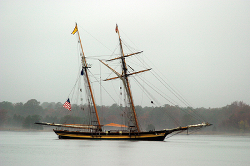 The Pride of Baltimore sails along the Tred Avon River, Chesapeake Bay.
The Pride of Baltimore sails along the Tred Avon River, Chesapeake Bay.
Image courtesy of Ben Longstaff - IAN, UMCES.
Maryland's National Treasure
The Chesapeake Bay is intrinsic to life in Maryland. It is part of our state identity, local culture (leaving MDE), and a vibrant part of Maryland's history and State pride (leaving MDE).
The Chesapeake is a natural wonder that thousands of people travel great distances to experience for only a short time. It provides its inhabitants with a wealth of resources, natural beauty, economic well-being, and national identity. Chesapeake Bay is our National Treasure; a treasure worth investing in, preserving, and protecting for future generations of Marylanders to enjoy.
Ecosystem Services
Maryland Is Taking Action
The Chesapeake Bay provides countless environmental, social, and economic benefits. Bay cleanup efforts ensure that we preserve and protect our National Treasure for future generations.
Learn More
Many of the animals in the Bay perform ecosystem services (leaving MDE). In other words, these organisms perform a service that benefits the environment, including filtering water or preventing shoreline erosion. One of the most prominent examples in the Chesapeake of an organism performing an ecosystem service is the native eastern oyster (Crassostrea virginica) (leaving MDE). These small mollusks are capable of filtering large volumes of water and were once one of the primary filters of the Bay. In addition to cleaning the Bay's waters, Chesapeake Bay oysters continue to be a popular delicacy that many Marylanders enjoy.
Other organisms play various roles in maintaining the health of the Bay and form a delicate, interconnected web that helps protect the Chesapeake from pollution. The combined ecosystem services provided by these animals are irreplaceable and are worth billions of dollars in benefits to humans (PDF - leaving MDE).
 Maryland watermen make their living working on the Chesapeake Bay.
Maryland watermen make their living working on the Chesapeake Bay.
Image courtesy of Jane Hawkey - IAN, UMCES.
Fisheries
The Chesapeake Bay is one of the most productive fisheries in the United States and is estimated to be responsible for more than one-third of the Nation's annual blue crab harvest (leaving MDE). In 2014, watermen in Maryland harvested approximately 49 million pounds of seafood from the Chesapeake, valued at nearly 90 million dollars dockside (leaving MDE).
In addition to blue crabs, the Bay provides rockfish (leaving MDE), shad (leaving MDE), oysters (leaving MDE), clams (leaving MDE), and other seafood. The bountiful waters of the Chesapeake form an important part of the Maryland economy and have provided a livelihood for thousands of watermen and other seafood industry workers for hundreds of years.
Recreation
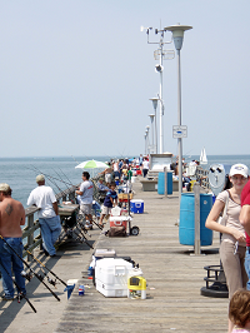 Pier fishing along Chesapeake Bay is one of many recreational activities both residents and tourists can enjoy.
Pier fishing along Chesapeake Bay is one of many recreational activities both residents and tourists can enjoy.
Image courtesy of Ben Fertig - IAN, UMCES.
The Chesapeake Bay offers many opportunities (leaving MDE) for recreational fishing, boating, bird watching, and other outdoor activities. Flowing through the heart of Maryland, the Chesapeake is central to our way of life. The wealth of outdoor opportunities (leaving MDE) and natural riches the Bay provides makes Maryland a desirable living area for humans. A healthy and clean Chesapeake provides innumerable benefits and improves our quality of life.
Tourism
Fresh local seafood, historical waterfront towns, sailboats on scenic rivers, and a wealth of wildlife have long made Maryland an attractive travel destination (leaving MDE), driving a healthy tourism industry. A vibrant Chesapeake brings thousands of tourists to Maryland every year to enjoy our National Treasure and support local businesses (leaving MDE).
Up Next: Challenges for the Chesapeake
Maryland's National Treasure faces a severe threat from nutrient pollution that degrades water quality and threatens the health of the Bay. Degraded water quality harms the Bay, the local economy, and our quality of life.
Learn more about how nutrient pollution harms the Bay.
Contact Information